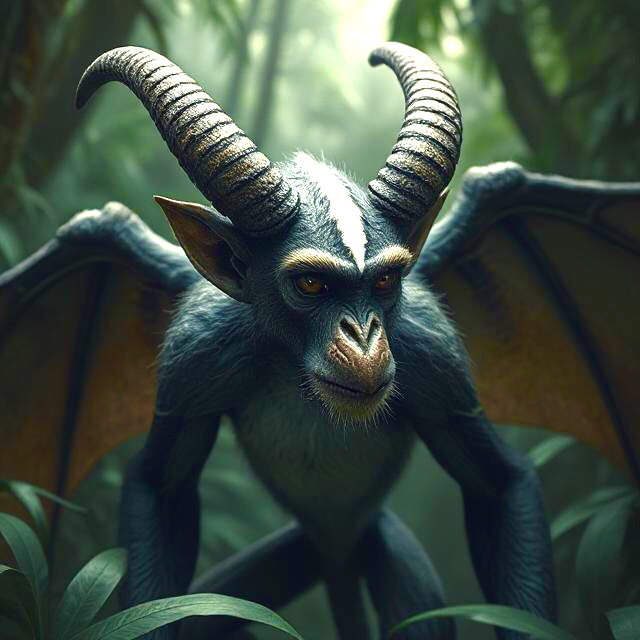
- Intent: To create a rare species to interact with on Tython.
- Image Credit: DeepAI
- Canon: N/A
- Permissions: N/A
Links: Tython
GENERAL INFORMATION
- Name: Jamarti
- Designation: semi-sentient
- Origins: Tython
- Average Lifespan: 50-60 years
- Estimated Population: Rare [estimated pop. 400]
- Description: A race of bipedal, winged mammals who are rarely sighted in the forests and mountains of Tython
PHYSICAL INFORMATION
- Breathes: Type I
- Average Height of Adults: 1.3 meters
- Average Length of Adults: N/A
- Skin color: Dark brown, Black, Orange
- Hair color: Dark brown, Black, Orange
- Distinctions: Mammals who are capable of flight as well as bipedal movement on two legs. They boast a set of horns once they reach late adolescence [approx years 17-20]. These horns are used for defense and are seen on both males and females. All Jamarti have a curious and distinct white stripe running down their foreheads, even from birth. As they progress in age the hair that covers their bodies will lighten and turn either gray or white. A healthy Jamarti will typically live between 50 to 60 years, and many see that age due to their skill in hiding on Tython. It is extremely rare to see one outside of that planet, and only then it would have been captured and caged. They are extremely swift in flight when using their wings, which are large and have a leathery feel. A Jamarti's wings grow in size with each passing year, until they reach their late 40s, when they reach a standstill.
- Races: N/A
- Force Sensitivity: Rare
Strengths:- Physical strength
Flight
Weaknesses:-
Primitive technology
Limited cognitive abilities
CULTURE- Diet: Omnivore. Plants, trees, fruits, insects, some small fish.
- Communication: Barks and yips, and some body language with their hands. This technique was developed within their own race so others would not understand it.
- Technology level: Primitive
- Religion/Beliefs: None, though they do mark the passing of one of their own by holding a sort-of funeral.
- General behavior: As far as it is known, Jamarti are scattered into roughly four or five different groups of approximately one hundred throughout the planet of Tython. The distance between their different “clans” is vast because they are very territorial and have the ability to cover much ground. They are typically led by one male figure, although there is a known tribe that is led by females, and this group is known to kick its males out once they reach late adolescence. The Jamarti hunt by both flight and darting through the forest trees. They typically survive on a herbivore diet but can be omnivorous if the situation presents. They have the ability to swim and have been seen fishing using crude instruments made of natural netting. They do not have the vocal components necessary for basic language. Instead they rely on deep grunts and barks, as well as pointing. When hunting they fly in small packs of three or four to avoid detection. They are capable of surviving in the uppermost cold mountain ranges to avoid detection, but typically prefer the warmer climate of the forests.
HISTORICAL INFORMATION
Very little is known of Jamarti history. It is possible they evolved from another bipedal species several million years ago, but developed flight in order to better hunt and navigate around the mountains and tall forests.
Although Jamarti are fiercely patriarchal in their behavior, females are treated with great care, as they produce offspring. When a female is known to be pregnant she is not expected to do anything, and males will hunt for her, although the Jamarti do not pair for life and have multiple mates.
Although they have no spoken or written language they have been seen communicating with one another using their fingers and hands. If they have any understanding of the technology of the galaxy, they have shown little interest in it as a whole, with even fire being regarded as something foreign and frightening to most.
They used to be much larger in number, with scientists estimating around one million lived on Tython at one time prior to the onset of the Clone Wars. Since then their numbers have fallen, likely due to greater exposure to foreign species and poaching for their magnificent horns.
But in recent years their numbers have steadied, and could possibly see an uptick, depending on their relations with the Jedi and any other groups moving to Tython.





